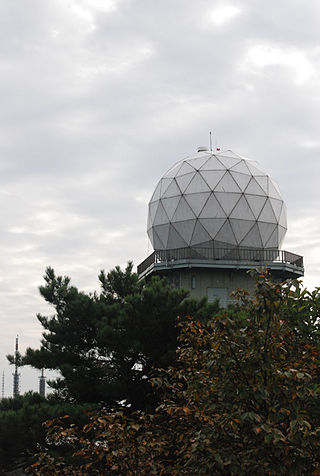
The World Meteorological Organization (WMO) is a specialized agency of the United Nations responsible for promoting international cooperation on atmospheric science, climatology, hydrology and geophysics.

The Meteorological Office, abbreviated as the Met Office, is the United Kingdom's national weather and climate service. It is an executive agency and trading fund of the Department for Science, Innovation and Technology and is led by CEO Penelope Endersby, who took on the role as Chief Executive in December 2018 and is the first woman to do so. The Met Office makes meteorological predictions across all timescales from weather forecasts to climate change.

The Japan Meteorological Agency, a division of the Ministry of Land, Infrastructure, Transport and Tourism, is dedicated to the scientific observation and research of natural phenomena. Headquartered in Minato, Tokyo the agency collects data on meteorology, hydrology, seismology, and volcanology, and other related fields.

The Paya Lebar Air Base is a military airbase of the Republic of Singapore Air Force (RSAF) in Singapore located at Airport Road in Paya Lebar, in the eastern region of Singapore. The airbase goes by the motto of Strength Through Readiness.

Singapore is a city-state and island country in maritime Southeast Asia, located at the end of the Malayan Peninsula between Malaysia and Indonesia as well as the Straits of Malacca and the South China Sea. It is heavily compact and urbanised. As of 2023, Singapore has a total land area of approximately 750 square kilometres (290 sq mi). Singapore is separated from Indonesia by the Singapore Strait and from Malaysia by the Straits of Johor.
The Bureau of Meteorology is an executive agency of the Australian Government responsible for providing weather services to Australia and surrounding areas. It was established in 1906 under the Meteorology Act, and brought together the state meteorological services that existed before then. The states officially transferred their weather recording responsibilities to the Bureau of Meteorology on 1 January 1908.

The Deutscher Wetterdienst or DWD for short, is the German Meteorological Service, based in Offenbach am Main, Germany, which monitors weather and meteorological conditions over Germany and provides weather services for the general public and for nautical, aviation, hydrometeorological or agricultural purposes. It is attached to the Federal Ministry for Digital and Transport. The DWDs principal tasks include warning against weather-related dangers and monitoring and rating climate changes affecting Germany. The organisation runs atmospheric models on their supercomputer for precise weather forecasting. The DWD also manages the national climate archive and one of the largest specialised libraries on weather and climate worldwide.

The Philippine Atmospheric, Geophysical and Astronomical Services Administration is the National Meteorological and Hydrological Services (NMHS) agency of the Philippines mandated to provide protection against natural calamities and to ensure the safety, well-being and economic security of all the people, and for the promotion of national progress by undertaking scientific and technological services in meteorology, hydrology, climatology, astronomy and other geophysical sciences. Created on December 8, 1972, by reorganizing the Weather Bureau, PAGASA now serves as one of the Scientific and Technological Services Institutes of the Department of Science and Technology.
Meteorological Service of New Zealand Limited, or simply MetService, is the national meteorological service of New Zealand. MetService was established as a state-owned enterprise in 1992. It employs about 300 staff, and its headquarters are in Wellington, New Zealand. Prior to becoming a state-owned enterprise, New Zealand's national meteorological service has existed in a number of forms since the appointment of the country's first Director of Meteorological Stations in August 1861.

The Pakistan Meteorological Department (PMD) (Urdu: محکمہ موسمیات پاکستان, also known as Pakistan Met Office), is an autonomous and independent institution tasked with providing weather forecasts and public warnings concerning weather for protection, safety and general information.

Singapore Changi Airport is a major international airport that serves Singapore, and is one of the largest transportation hubs in Asia. More than 100 airlines operate from the airport, with flights to destinations in Asia, Oceania, Africa, Europe, the Middle East, and North America.

The State Meteorological Agency is a state agency of the Government of Spain responsible for providing weather forecast, warnings of hazardous weather and assisting the administrations in such matters. The AEMET is part of the Secretariat of State for Environment of the Ministry for the Ecological Transition and is headquartered in the University City, Madrid. The agency was known as Central Institute of Meteorology from 1887 to 1978 and National Institute of Meteorology from 1978 to 2008 when it adopted its current name.

The Korea Meteorological Administration is the national meteorological service of the Republic of Korea. The service started in 1904 joining the WMO in 1956. Numerical weather prediction is performed using the Unified Model software suite.

The Central Institution for Meteorology and Geodynamics is the national meteorological and geophysical service of Austria.

The Croatian Meteorological and Hydrological Service is a public entity for meteorology, hydrology and air quality in Croatia.

Regional Meteorological Centre, Chennai is one of the six regional meteorological centres (RMCs) of the India Meteorological Department (IMD) and is responsible for the weather-related activities of the southern Indian peninsula comprising the states of Andhra Pradesh, Telangana, Karnataka, Kerala, Tamil Nadu and the union territories of Andaman and Nicobar, Lakshadweep Islands and Puducherry. The other regional centres are located at Kolkata, Guwahati, Mumbai, Nagpur and New Delhi.

The Tuvalu Meteorological Service (TMS) is the principal meteorological observatory of Tuvalu and is responsible for providing weather services to the islands of Tuvalu. A meteorological office was established on Funafuti at the time the islands of Tuvalu were administered as parts of the Gilbert and Ellice Islands colony of the United Kingdom. The meteorological office is now an agency of the government of Tuvalu.
Abdulla Ahmed Al Mandous is the current President of WMO. Al Mandous was elected as WMO president for a four-year term from 2023 to 2027 by the representatives of WMO's 193 member states and territories which convened in Geneva for the body's 19th annual congress from 22 May to 2 June 2023. Al Mandous is also Director General of the National Center of Meteorology (NCM), the government entity that provides meteorological and seismological services and statistical data and information to various entities and the public in the United Arab Emirates to carry out their daily functions.















